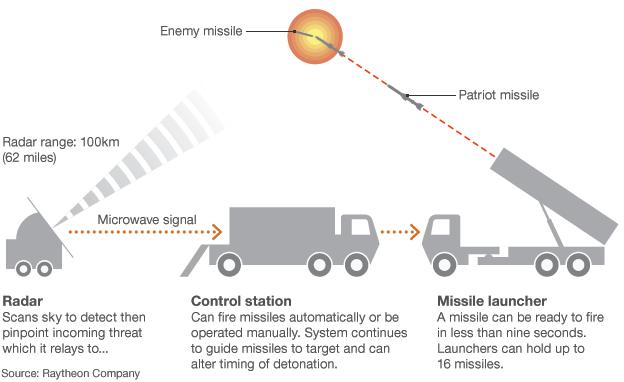Fact file: Patriot missile defence
- Published

The Patriot is an advanced surface-to-air missile system intended to defend against aircraft, cruise and ballistic missiles.
Production began in 1980 and the missile was first deployed in combat in 1990/91 after Iraq's invasion of Kuwait, though its performance against Iraqi scud missiles was much less spectacular than initially claimed.
Since then successive versions of the system have been upgraded and enhanced giving it a much greater capability against ballistic missiles. It was again deployed to the Middle East during Operation Iraqi Freedom in 2003.
Patriot is operated by twelve countries around the world including the US, the Netherlands, Germany, Japan, Israel, Saudi Arabia, Kuwait, Taiwan, Greece, Spain, South Korea and the United Arab Emirates.
The system is based upon wheeled trailers. It is mobile and can be carried in a C5 Galaxy transport aircraft. Units are inter-operable so Nato countries can put together a defensive package and deploy it to a far-flung region, as the Alliance is planning to do on the Turkish-Syrian border.
Missiles
A Patriot system is made up of four main elements: a radar, control centre and associated power supply and communications towers, and launchers on trucks.
The manufacturer says it can take 16 launchers, the US Army uses usually five to eight in a battery.
Each launcher holds four missiles - or 16 in the latest "Pac-3" version.
The launchers can be up to a kilometre away from the radar and control hub, linked by microwave signals.
The trailer-mounted radar is a "phased array" type - it scans the sky with a narrow beam which flicks between thousands of locations each second.
If it detects something, up to 62 miles (100 km) away, it focuses on it and relays information about it to the control centre.
It can track up to 100 targets and send guidance data for up to nine missiles.
Automatic fire
The "engagement control station" has three operators, with two radar consoles and a radio link.
The system can be automated, although an operator is able to override it.
When the control computer has decided the best time to launch, it tells a launcher to fire a missile or missiles - typically two might be fired at a target in rapid succession because one alone does not guarantee a hit.
The five-metre-long missiles are supersonic within moments of leaving the launcher, having taken their initial course from the control computer, and accelerate to five times the speed of sound.
Tracking
The latest, smaller version of the missile does have a warhead but is meant to destroy its target primarily by simply hitting it. It has its own "seeker" to fine tune its approach to the target.
The older type weighs almost three times as much and has a range of up to 100 miles (160km). It uses a more complex process called "track via missile".
The Patriot missile homes on an electronic signal "painted" on the target by the radar, and relays its position in relation to the target back to the radar and on to the control centre.
Updated flight instructions are sent back up to the missile to guide it to the target. The computer can adjust the missile's fuse, depending on the target, to decide the best moment to detonate the 198lb (90kg) warhead.
A drawback to this method is it takes at least nine seconds from launch to become effective.